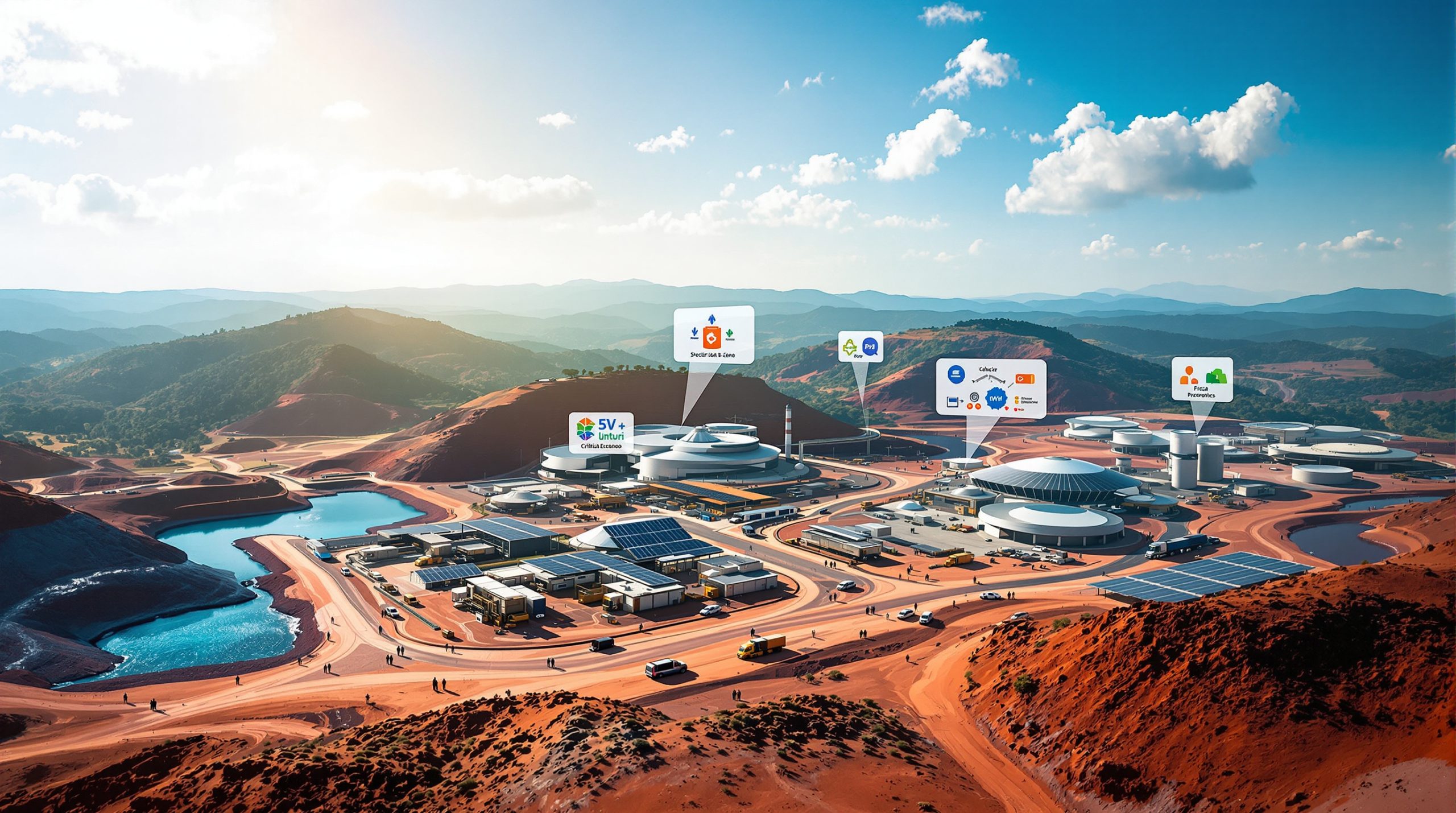ABAT's Nevada Lithium Project Gains Federal Priority Status: A Critical Milestone for US Mineral Independence
American Battery Technology Company's (ABTC) Tonopah Flats Lithium Project in Nevada has recently achieved a significant milestone by securing FAST-41 designation on the Federal Permitting Dashboard. This development marks a pivotal moment in the United States' efforts to establish domestic critical mineral supply chains and reduce dependency on foreign sources. The project's federal priority status not only accelerates its development timeline but also signals the strategic importance of ABAT's Nevada lithium project added to US federal permitting dashboard to America's energy future and national security interests.
What is the Tonopah Flats Lithium Project?
The Tonopah Flats Lithium Project represents one of America's most promising domestic lithium resources, strategically positioned to address growing demand for battery materials in the clean energy transition. Located in mineral-rich central Nevada, this project has captured attention for both its scale and strategic significance.
Overview of ABAT's Nevada Lithium Resource
Situated in central Nevada's Tonopah mining district, the Tonopah Flats project encompasses approximately 10,340 acres of lithium-bearing claystones. Geological surveys and exploratory drilling have confirmed this as one of the largest identified claystone lithium deposits in the United States, positioning it as a cornerstone resource in the domestic battery supply chain.
American Battery Technology Company (ABTC) serves as the project developer, bringing specialized expertise in lithium extraction from claystone deposits. The company's integrated approach combines resource development with advanced processing technologies, creating a comprehensive solution to America's lithium needs.
"We are excited by this selection of our Tonopah Flats Lithium Project as a FAST-41 critical mineral Transparency Project," noted Ryan Melsert, ABTC's CEO. "The support to coordinate and fast-track these efforts is greatly appreciated."
The project's strategic location offers significant logistical advantages, with proximity to existing transportation infrastructure and Nevada's established mining support ecosystem. Additionally, the site sits within 300 miles of Tesla's Gigafactory Nevada, creating potential for a localized supply chain that minimizes transportation costs and carbon footprint.
Geological Significance of the Tonopah Flats Deposit
The Tonopah Flats resource differs significantly from the brine deposits found in South America's "Lithium Triangle" or the hard-rock spodumene operations of Australia. As a claystone deposit, it presents unique characteristics that influence extraction methodology and economics:
- Resource distribution: Unlike concentrated brine pools, claystone lithium is distributed throughout sedimentary layers, creating a different extraction challenge
- Concentration levels: Typical grades range from 1,000-3,000 parts per million (ppm) lithium
- Extraction complexity: Requires specialized hydrometallurgical processes rather than evaporation or crushing methods
- Processing innovations: Demands novel technological approaches to achieve economic viability
Compared to other major U.S. lithium projects like Thacker Pass lithium mine in northern Nevada, Tonopah Flats shares geological similarities while offering distinct advantages in terms of accessibility and infrastructure proximity. Both projects represent the emerging "claystone frontier" in lithium mining—a departure from traditional extraction methods that could revolutionize the industry's approach to previously overlooked resources.
The claystone composition presents both challenges and opportunities. While lithium concentration is typically lower than in high-grade hard rock deposits, the more homogeneous distribution and potentially simpler processing requirements could offset these disadvantages with properly engineered extraction methods.
Why Was the Project Added to the Federal Permitting Dashboard?
The addition of Tonopah Flats to the Federal Permitting Dashboard represents a significant vote of confidence from the U.S. government in the project's strategic importance. This designation, announced on July 2, 2023, places the project among a select group of infrastructure initiatives deemed critical to national interests.
Understanding the FAST-41 Designation
The Federal Permitting Improvement Steering Council (FPISC) administers the FAST-41 program (Fixing America's Surface Transportation Act, Title 41), which was designed to improve the timeliness, predictability, and transparency of federal environmental reviews and authorizations for covered infrastructure projects.
Transparency Priority Project status under FAST-41 is reserved for infrastructure developments that:
- Involve multiple federal agencies and complex permitting requirements
- Represent significant investments (typically exceeding $200 million)
- Support critical national priorities, particularly in energy and minerals
- Benefit from enhanced coordination across agencies
This designation doesn't circumvent environmental regulations or public input processes. Rather, it ensures greater agency accountability and coordination, preventing bureaucratic delays while maintaining rigorous environmental standards.
Historically, critical mineral projects that have received this designation include the Thacker Pass lithium mine (also in Nevada) and several rare earth element operations. These precedents demonstrate the federal government's increasing recognition of domestic mineral supply chains as infrastructure priorities on par with major energy and transportation projects.
Benefits of Federal Permitting Dashboard Inclusion
The practical benefits of Tonopah Flats' inclusion on the Federal Permitting Dashboard extend far beyond symbolic recognition. This designation delivers tangible advantages that could significantly accelerate the project's development timeline:
- Streamlined agency coordination: A designated Federal Permitting Dashboard Facilitator coordinates activities across multiple agencies including the Bureau of Land Management, Environmental Protection Agency, and U.S. Fish and Wildlife Service
- Transparent permitting timetables: Public dashboard tracking shows real-time progress on permitting milestones, reducing uncertainty
- Shortened review timelines: Data indicates FAST-41 projects experience approximately 20% faster permitting processes compared to similar non-designated projects
- Dispute resolution mechanisms: Formalized processes prevent inter-agency disagreements from creating delays
- Enhanced visibility: Dashboard status attracts attention from investors, partners, and stakeholders
For ABTC, these benefits translate to potential time savings of 12-18 months in the overall development timeline—a significant advantage in the race to establish domestic lithium production. This acceleration doesn't compromise environmental standards but eliminates redundancies and improves process efficiency.
The dashboard also creates accountability through public transparency, allowing all stakeholders to monitor progress and identify potential bottlenecks before they cause significant delays. This visibility benefits not only ABTC but the entire lithium supply chain planning process, from battery manufacturers to automakers.
How Does This Support US Critical Mineral Strategy?
The prioritization of the Tonopah Flats project aligns perfectly with broader national security and industrial policy objectives focused on securing domestic supply chains for critical minerals. This strategic alignment explains why federal agencies have taken a special interest in accelerating the project's development.
Domestic Lithium Production Challenges
The United States currently faces a profound dependency on foreign lithium sources, with approximately 80% of supply coming from imports according to the U.S. Geological Survey. This dependency creates multiple vulnerabilities:
- Supply concentration risk: Chile, Australia, and China control most global production
- Geopolitical exposure: Trade disputes or political tensions could disrupt supply
- Currency and pricing volatility: Dollar fluctuations affect import costs
- Transportation vulnerabilities: Extended supply chains susceptible to disruption
Current domestic production accounts for less than 2% of global lithium output, a stark contrast to America's position as the world's second-largest consumer of lithium materials. This imbalance is particularly concerning as demand projections show U.S. lithium needs growing exponentially, potentially reaching 500,000 metric tons annually by 2030 (Benchmark Minerals Intelligence).
The Department of Energy estimates that domestic lithium production capacity would need to increase by more than 40 times current levels to meet projected 2040 demand from the electric vehicle and grid storage sectors alone. This massive gap underscores the importance of accelerating projects like Tonopah Flats.
National Security and Energy Independence Implications
Lithium has transcended its commercial importance to become a strategic material central to both energy transition and defense capabilities:
"Lithium is not just a battery material—it's a national security imperative," notes a recent Department of Defense assessment. "From electric vehicles to grid-scale storage and defense applications, secure lithium supply chains underpin America's technological leadership."
The mineral's critical applications include:
- Energy storage systems for military installations and forward operating bases
- Electric mobility platforms for tactical and logistics vehicles
- Advanced electronics for communications and weapons systems
- Grid resilience to protect critical infrastructure from disruption
Beyond direct defense applications, lithium underpins the broader critical minerals energy transition that the Department of Defense has identified as a national security priority. Climate change impacts are increasingly recognized as threat multipliers that could destabilize regions and increase humanitarian crises.
The Tonopah Flats project connects directly to several federal initiatives, including:
- The Defense Production Act Title III program for critical minerals
- The Inflation Reduction Act's domestic content provisions
- The Bipartisan Infrastructure Law's battery material funding
- The Energy Act of 2020's critical mineral provisions
By supporting accelerated development of domestic lithium resources, these programs aim to reduce America's strategic vulnerability to supply disruptions while creating economic opportunities in regions with mineral resources.
What Permitting Hurdles Does the Project Face?
Despite its priority designation, the Tonopah Flats project must still navigate a complex regulatory landscape designed to ensure environmental protection and public input. Understanding these hurdles provides context for why the FAST-41 designation is so valuable.
Current Regulatory Status
ABTC is actively progressing through multiple parallel permitting processes, each with distinct requirements and timelines:
- Bureau of Land Management (BLM): Environmental Assessment under the National Environmental Policy Act (NEPA)
- Environmental Protection Agency (EPA): Air quality permits and water discharge authorizations
- Nevada Division of Environmental Protection: State-level environmental permits
- Nevada Division of Water Resources: Water rights acquisitions and approvals
The project's current status includes completed baseline environmental studies and initiated agency consultations, with major permit applications submitted. Under standard timelines, the remaining regulatory process would typically require 3-5 years—the median for Nevada lithium projects according to the National Mining Association.
With FAST-41 designation, this timeline could potentially be compressed to 24-36 months through improved coordination rather than regulatory shortcuts. The dashboard provides a transparent view of which permits are on the critical path and which agencies are responsible for next steps.
For comparison, the Thacker Pass lithium mine spent approximately four years in the permitting process, followed by additional time addressing legal challenges. These precedents highlight the value of FAST-41's structured approach to preventing unnecessary delays.
Environmental and Community Considerations
The permitting process must address several key environmental and community concerns specific to lithium development in Nevada's high desert environment:
- Water resources management: In a region where water is precious, ABTC must demonstrate sustainable usage patterns that don't impact existing rights holders or ecological systems
- Habitat protection: Surveys for sensitive species including the Greater Sage-Grouse require thorough baseline documentation and mitigation planning
- Air quality impacts: Dust control and processing emissions require careful monitoring and mitigation
- Cultural resources: Archaeological surveys and tribal consultation address potential impacts to heritage sites
The project's location in Esmeralda County—one of Nevada's least populated counties—presents both challenges and opportunities for community engagement. While fewer residents are directly affected, the project represents a significant economic development opportunity in an area with limited employment options.
ABTC has initiated formal consultation with tribal nations having historical connections to the project area, including the Western Shoshone. This process involves identifying cultural resources, traditional use areas, and establishing ongoing dialogue mechanisms throughout the project lifecycle.
"Responsible development means not just checking regulatory boxes but genuinely engaging with communities to ensure shared benefits and minimized impacts," states ABTC's sustainability framework.
How Will This Project Impact the US Battery Supply Chain?
The Tonopah Flats project's significance extends far beyond its immediate economic footprint, potentially reshaping America's battery material supply chain and enhancing manufacturing competitiveness in electric mobility and energy storage.
Projected Production Capacity
While ABTC has not yet published finalized production targets, industry analysts and comparable projects suggest the following potential output scenarios:
- Initial phase: Estimated 5,000-10,000 metric tons of lithium carbonate equivalent (LCE) annually
- Full-scale operations: Potential for 30,000+ metric tons LCE annually
- Expansion potential: Resource size could support multiple decades of production
At full production, the project could supply approximately 6-8% of projected U.S. lithium demand by 2030, representing a significant contribution to domestic supply. This output would support battery production for approximately 500,000 electric vehicles annually, depending on battery sizes and chemistries.
The development timeline suggests a phased approach with:
- Pilot operations: 2026-2027 (small-scale production)
- Commercial production: 2028 (initial phase)
- Full capacity: 2030-2031 (subject to market conditions)
This gradual ramp-up allows for technology optimization and adaptation to evolving market conditions while generating early revenue streams to support continued expansion.
Downstream Integration Opportunities
ABTC's business model extends beyond traditional mining to encompass a more integrated approach to battery materials, creating multiple synergies:
- Co-location potential: Processing facilities positioned near extraction reduces transportation costs
- Recycling integration: ABTC's battery recycling technologies complement primary production
- Gigafactory proximity: Nevada's growing battery ecosystem offers natural customers
- Qualification advantages: Domestic materials may qualify for IRA tax credits and other incentives
The project's location within Nevada's emerging battery belt provides strategic advantages. Tesla's Gigafactory Nevada, Redwood Materials' recycling and cathode production facilities, and Panasonic's operations all lie within economically viable transportation distance, creating the potential for a regionalized supply chain that minimizes logistics costs and carbon emissions.
From a manufacturing competitiveness standpoint, domestically sourced lithium offers several advantages over imported materials:
- Supply chain resilience: Reduced vulnerability to international shipping disruptions
- Quality consistency: Direct relationships with producers enable tighter specifications
- Logistics simplification: Shorter supply chains with fewer international complexities
- Carbon footprint reduction: Minimized transportation distances support sustainability goals
The Inflation Reduction Act's domestic content provisions for electric vehicle tax credits further enhance the strategic value of U.S.-produced lithium, potentially creating premium pricing opportunities for domestic suppliers like ABTC.
Who Benefits from This Federal Designation?
The FAST-41 designation creates a cascade of benefits that extend well beyond ABTC's corporate interests, positively impacting multiple stakeholders across the economic spectrum from local communities to national strategic interests.
Industry Stakeholders
The designation strengthens several key players in the battery and electric vehicle ecosystem:
- ABTC: Enhanced project certainty improves financing options and accelerates timeline to revenue
- Battery manufacturers: Increased visibility into future domestic material supply supports capacity planning
- Automotive OEMs: More stable and predictable supply chains reduce production risks
- Mining service providers: Earlier project commencement creates additional service opportunities
- Technology suppliers: Equipment providers gain showcases for innovative extraction technologies
The designation also attracts attention from investors focused on critical minerals and energy transition materials. By reducing regulatory uncertainty—historically a major concern for mining investment—the FAST-41 status improves the project's risk profile and potentially lowers capital costs.
Strategic partnerships are also facilitated by the increased certainty provided by the dashboard. Potential offtake agreements, technology licensing, and joint ventures all become more feasible when permitting timelines are more predictable and transparent.
Regional and National Economic Impact
The economic benefits extend throughout the regional economy and contribute to broader national goals:
- Employment creation: Approximately 150-200 direct jobs during construction and 50-75 permanent operations positions
- Wage premium: Mining sector jobs typically pay 40% above regional average wages
- Skills development: Technical training opportunities in advanced manufacturing and processing
- Tax revenue generation: Estimated $5-7 million annually in combined local and state taxes
- Infrastructure improvements: Road upgrades and potential power infrastructure enhancements
- Supply chain development: Opportunities for local vendors and service providers
Esmeralda County, with a population under 1,000 residents, would experience significant positive economic impacts from this scale of development. The project represents a diversification opportunity in a region historically dependent on traditional mining industry evolution with boom-bust cycles.
At the national level, each job in lithium production supports approximately 3.5 additional jobs through supply chain and induced spending effects, according to economic multiplier analyses from the National Mining Association. This multiplier effect amplifies the project's economic impact well beyond the mine site.
The project also supports America's broader transition to clean energy by enabling domestic battery production, potentially reducing the carbon footprint associated with transportation and supporting energy independence goals.
What Technology Approaches Is ABTC Implementing?
ABTC's approach to lithium extraction represents a departure from conventional methods, emphasizing innovation to address the unique challenges of claystone deposits while prioritizing environmental performance.
Innovative Extraction Methods
Traditional lithium production methods—evaporation ponds for brines or crushing and chemical processing for hard rock—aren't optimal for claystone deposits. ABTC has developed proprietary technologies specifically engineered for Nevada's unique geology:
- Selective leaching: Targeted chemical processes that extract lithium while leaving most other materials in place
- Accelerated processing: Methods that reduce extraction time from months (evaporation ponds) to hours
Ready to Stay Ahead of the Next Major Discovery?
Discover why significant mineral finds like ABAT's Nevada lithium project can generate substantial returns by exploring Discovery Alert's dedicated discoveries page, featuring real-time alerts powered by the proprietary Discovery IQ model for ASX mineral announcements.




